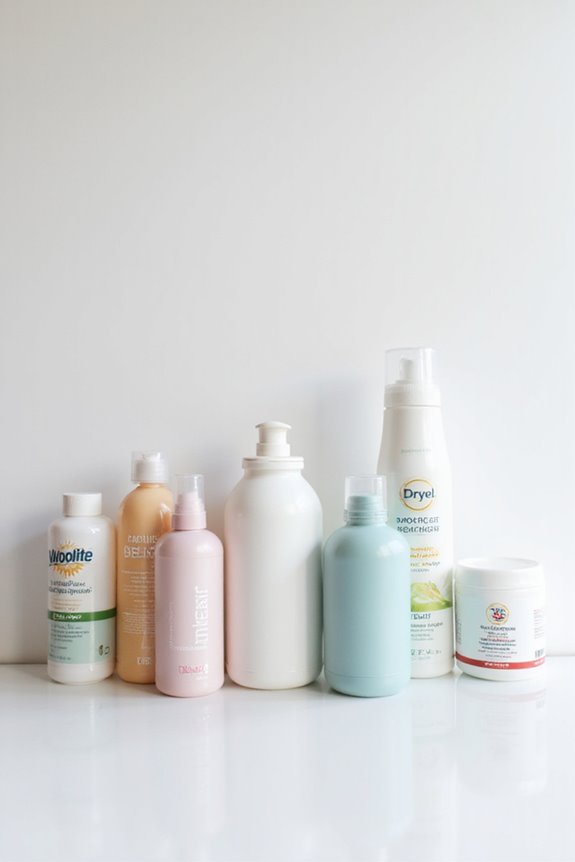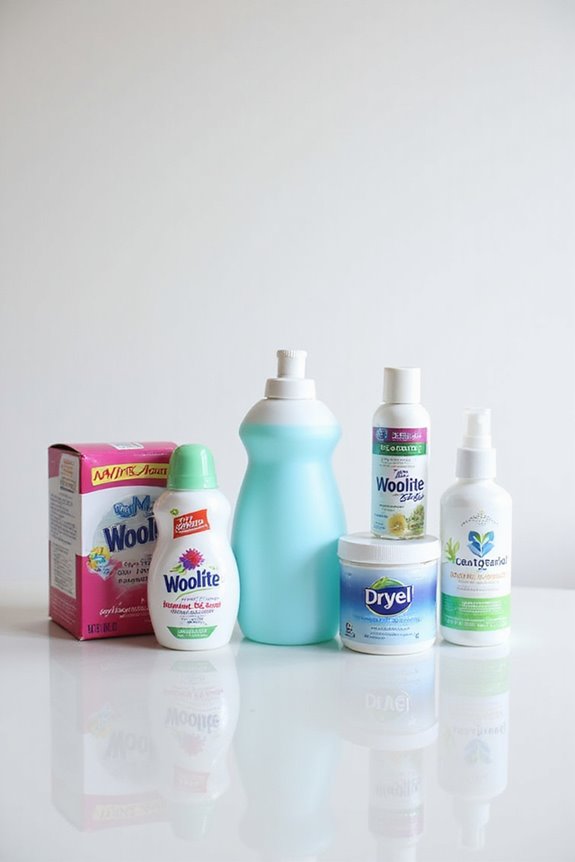Fabric softeners can definitely help reduce static cling in our laundry, but they don’t completely stop it. They work by coating the fibers, so they’re less likely to stick together. We’ve all experienced that annoying cling, especially during dry winter months. Using products like Snuggle Plus SuperFresh can really help, but it’s also good to sort our laundry by fabric type and avoid over-drying. Stick around, and we’ll share even more tips to tackle static.
Key Takeaways
- Fabric softeners reduce static cling by neutralizing charges on fabrics, thanks to their cationic surfactants.
- They are more effective on natural fibers than on synthetic materials, which can still generate static.
- While fabric softeners significantly help, they do not completely eliminate static electricity from laundry.
- Dry air conditions, especially in winter, can exacerbate static cling despite using fabric softeners.
- Using fabric softeners correctly, such as adding them during the rinse cycle, enhances their static-reducing effectiveness.
Understanding Static Electricity in Laundry
When we think about laundry, we often overlook something that can cause quite a bit of frustration: static electricity. It mainly comes from triboelectric charging, which happens when different fabrics rub together in the dryer. When we toss in synthetic fibers like polyester, they can accumulate static charge up to five times more than natural fibers. That’s a lot of zap! Mixed loads can generate even more static due to the friction between dissimilar materials. Plus, if our dryer is running too hot or we’re drying those clothes too long, it can lead to even more clinginess. So, let’s remember to sort our laundry by fabric type to help reduce that annoying static and keep our clothes feeling fresh! Additionally, using fabric softeners with pet hair repelling power can significantly help in reducing static cling during the drying process.
How Fabric Softener Works to Reduce Static
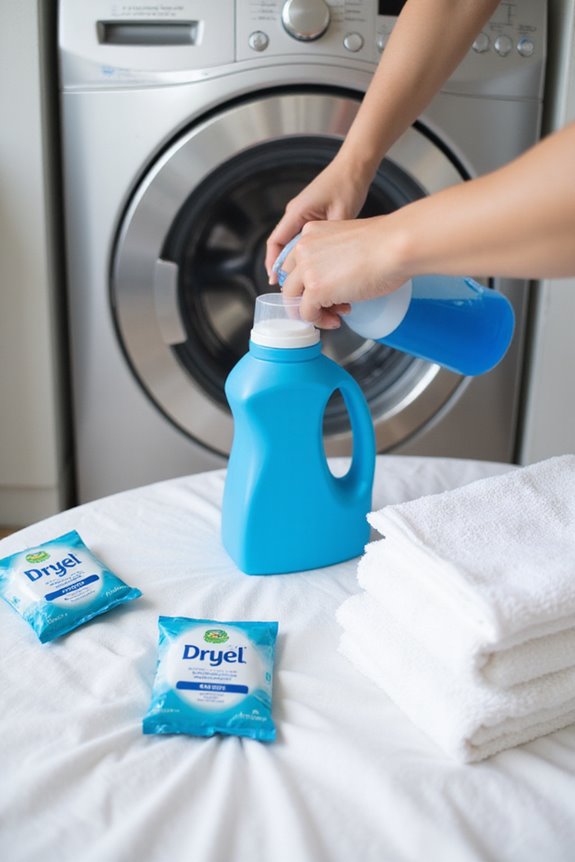
Static cling can really be a headache, especially when we’re trying to pull on our favorite sweater and it seems to have a mind of its own. Fortunately, fabric softeners come to the rescue! They work by coating the fibers with electrically charged compounds that neutralize those pesky negative charges. This reduces static cling and makes our clothes feel softer too. Additionally, many fabric softeners, such as Snuggle Plus SuperFresh Dryer Sheets, combine odor-eliminating technology with fabric softening for a more pleasant laundry experience.
The Role of Fabric Softener Ingredients

Fabric softener ingredients play an essential role in keeping our clothes feeling fresh and static-free. The primary players here are cationic surfactants. These positive-charged agents stick to negatively charged fibers like cotton, neutralizing static electricity. It’s like a superhero for our laundry! Newer formulations are even better, allowing static to dissipate effectively.
Besides surfactants, we often find quaternary ammonium compounds and plant-based extracts in these products. These ingredients help create a lubricating film, reducing friction between fibers. But let’s not forget about those dryer sheets! They’re loaded with stearic acids to defeat static cling while tumbling. Additionally, many fabric softeners are designed to be hypoallergenic and dermatologist-tested, making them suitable for sensitive skin. So, the next time we toss in a fabric softener, we can appreciate the blend of surfactant types working hard for static-free clothes!
Best Practices for Using Fabric Softener
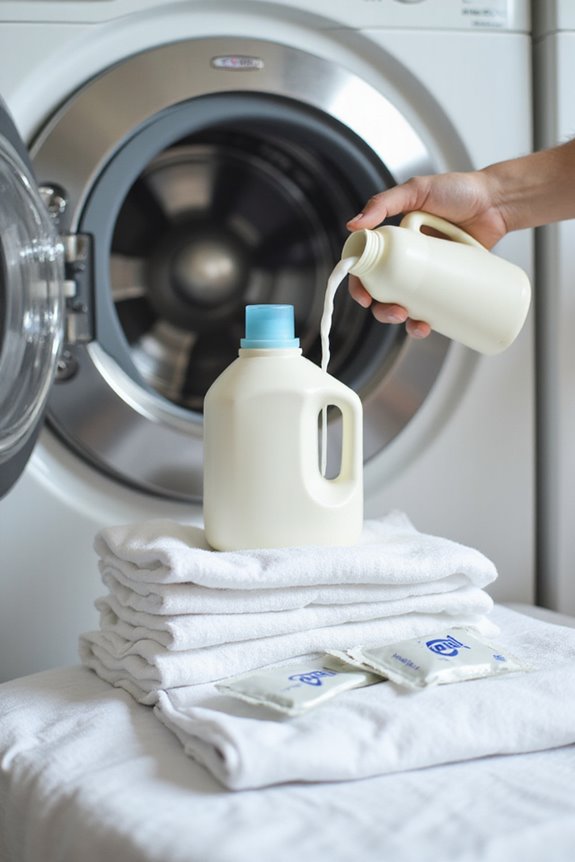
Using fabric softener can really enhance our laundry experience, especially after learning about its ingredients. To optimize fabric softener usage, we should add it during the rinse cycle, using the machine’s dispenser if available. If not, pouring it into water pockets helps avoid stains. It’s important to follow the recommended amount based on load size and water hardness—less is often more! For front-loaders, let’s use the designated compartment, and remember, direct contact with clothes can lead to stains. We also want to separate our laundry by fabric type. Finally, fabric softener sheets work wonders in the dryer. By following these best practices, our laundry care routine can be both effective and enjoyable. Additionally, using fabric softeners can help reduce static cling issues, making our clothes feel more comfortable and easy to manage. Happy washing!
Additional Methods to Prevent Static Cling
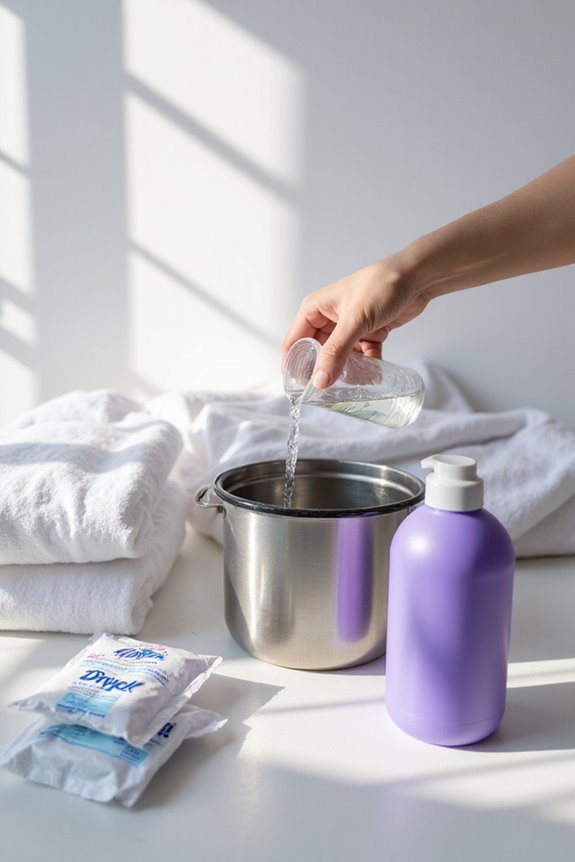
When we’re tackling the pesky issue of static cling, it’s good to know we have several tricks up our sleeves. One effective method is using static reducing sprays. They add moisture to our clothes, helping prevent static buildup. We can apply them right before we wear our clothes or after drying. Additionally, many sprays, like Static Guard Fabric Spray, are designed to be safe on all colorfast fabrics, making them versatile for various clothing types.
Another great technique is steam drying. It uses hot, moist air to neutralize static charges while also reducing wrinkles. Additionally, sorting our laundry by fabric type minimizes friction. We should separate synthetic fabrics from natural fibers for better results.
Finally, air drying is a simple solution. It eliminates tumbling friction and helps retain moisture. Remember, a little humidity control goes a long way in keeping static at bay!
Common Misconceptions About Fabric Softener and Static
Have you ever wondered why static cling still happens even after using fabric softener? Well, it turns out that fabric softeners don’t completely prevent static cling. They help by coating clothes with positively charged ions, but they can’t eliminate static in all situations. Plus, static cling is often worse in dry air, like during winter.
Another misconception is that fabric softener works the same on all fabric types. It’s more effective on natural fibers, but it can actually damage moisture-wicking athletic wear and other specialty fabrics. So, while fabric softeners are helpful, they aren’t a one-size-fits-all solution. Understanding these facts can help us choose the right method for tackling static cling effectively. Additionally, using a hypoallergenic option like Downy Free & Gentle can be beneficial for those with sensitive skin or allergies.
Frequently Asked Questions
Can Fabric Softener Be Used on All Fabric Types?
Using fabric softener is like choosing a dance partner; not all fabrics are compatible. While cotton and synthetics waltz well, towels and athletic wear might stumble. We should always check fabric types for compatibility.
How Does Humidity Affect Static Cling in Laundry?
Humidity levels play an essential role in static electricity. When humidity’s low, static cling increases due to dry air. Conversely, higher humidity reduces static by allowing moisture to disperse charges on our fabrics more effectively.
Are There Any Alternatives to Fabric Softener for Static Reduction?
We’ve all experienced static cling, haven’t we? Instead of fabric softeners, we can use dryer balls, vinegar alternatives, essential oils, or even baking soda to reduce static naturally and keep our laundry fresh and soft.
Does Fabric Softener Affect the Absorbency of Towels?
We’ve found that fabric softener negatively impacts towel performance by leaving a coating that reduces water absorption. This affects the fabric composition, making towels less effective and ultimately shortening their lifespan. Let’s consider alternatives for better results!
Can I Use Too Much Fabric Softener?
We can definitely use too much fabric softener. While it offers benefits like softness, excessive use leads to residue buildup, reduced absorbency, and even health risks, so let’s stick to recommended amounts for the best results.

